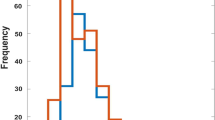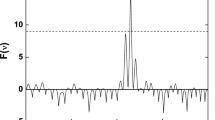Abstract
Our paper is dedicated to the problem of anomalous values of braking indices n obs and spin frequency second derivatives \(\ddot \nu\) of isolated radio pulsars. Observations of these objects for over 40 years have shown that in addition to the complex short-term irregular component in the evolution of the pulsars’ frequency, secular values of its second derivative are orders of magnitude greater than the predicted theoretical ones, and in a good half of cases—they are even negative. We earlier attributed this behavior of secular values of the second derivative to the presence of a cyclic component in the secular evolution of ν(t), with a characteristic recurrence time of thousands to tens of thousand years. We continue to develop this hypothesis based on a more detailed statistical analysis of the characteristics of 297 isolated radio pulsars: we analyze the model of these objects spin-down, consisting of two components, monotonic and cyclic, and determine their parameters. We demonstrate that the monotonic spin-down component is described by the classical magnetodipolar power law with an braking index of about 3, while the large amplitude of the cyclic component causes a significant variation of the observed spin-down rate \((\dot \nu )\) (with respect to magnetodipolar one), and fully determines the anomalous values of \(\ddot \nu\) and n obs. An important consequence of the existence of a cyclic component of the pulsar rotational variations is the difference between their characteristic ages and respective secular values (by about 0.5–5 times). This allows to explainthe observed discrepancy of the characteristic and physical ages of some objects, as well as very large, up to 108 years, characteristic ages of some old pulsars. The paper argues that the cyclic component of the observed spin-down is due to the long-term precession of neutron stars around their magnetic axes, which, in particular, may be driven by the anomalous braking torque. In the model of purely magnetodipolar braking this torque is a consequence of emission in the near field zone.
Similar content being viewed by others
References
R. N. Manchester and J. H. Taylor, Pulsars (Freeman and CO, San Francisco, 1977) [in Russian].
V. Beskin, A. Gurevich, and Ya. Istomin, Physics of the PulsarMagnetosphere, (Cambridge: Cambridge University Press, 1993).
F. D’Alessandro, P. M. McCulloch, E. A. King, et al., Monthly Notices Roy. Astronom. Soc. 261, 883 (1993).
A. Baykal, M. Ali Alpar, P. E. Boynton, et al., Monthly Notices Roy. Astronom. Soc. 306, 207 (1999).
G. Hobbs, A. G. Lyne, M. Kramer, et al., Monthly Notices Roy. Astronom. Soc. 353, 1311 (2004).
G. Hobbs, A. G. Lyne, and M. Kramer, Monthly Notices Roy. Astronom. Soc. 402, 1027 (2010).
M. A. Livingstone, V. M. Kaspi, F. P. Gavriil, and R. N. Manchester, Astrophys. J. 619, 1046 (2005).
C. M. Espinoza, A. G. Lyne, B. W. Stappers, and M. Kramer, Monthly Notices Roy. Astronom. Soc. 414, 1679 (2011).
K. S. Cheng, Astrophys. J. 321, 799 (1987).
I. Contopoulos, Astronom. and Astrophys. 475, 639 (2007).
J. M. Cordes and G. S. Downs, Astrophys. J. Suppl. 59, 343 (1985).
J. O. Urama, B. Link, and J. M. Weisberg, Monthly Notices Roy. Astronom. Soc. 370, L76 (2006).
A. Lyne, G. Hobbs, M. Kramer, et al., Science 329, 408 (2010).
J. M. Cordes and G. Greenstein, Astrophys. J. 245, 1060 (1981).
Z. Arzoumanian, D. J. Nice, J. H. Taylor, et al., Astrophys. J. 422, 671 (1994).
A. E. Chukwude, Astronom. and Astrophys. 406, 667 (2003).
D. M. Scott, M. H. Finger, and C. A. Wilson, Monthly Notices Roy. Astronom. Soc. 344, 412 (2003).
M. Demiańsky and M. Proszyński, Nature 282, 383 (1979).
M. A. Alpar and A. Baykal, Monthly Notices Roy. Astronom. Soc. 372, 489 (2006).
G. E. Gullahorn and J. M. Rankin, BAAS 9, 562 (1977).
A. V. Biryukov, On Some Peculiarities of the Evolution Periods of Radio Pulsars, graduation paper, Department of Physics, Moscow State University (2006).
G. Beskin, A. Biryukov, and S. Karpov, ar**v:astro-ph/0603375 (2006).
A. Biryukov, G. Beskin, S. Karpov, and L. Chmyreva, Adv. in Space Res. 40, 1498 (2007).
D. P. Barsukov and A. I. Tsygan, Monthly Notices Roy. Astronom. Soc. 409, 1077 (2010).
A. Melatos, Monthly Notices Roy. Astronom. Soc. 313, 217 (2000).
R. N. Manchester, G. B. Hobbs, A. Teoh, et al., Astronom. J. 129, 1993 (2005).
S. Johnston and D. Galloway, Monthly Notices Roy. Astronom. Soc. 306, L50 (1999).
A. Biryukov, G. Beskin, and S. Karpov, submitted to Monthly Notices Roy. Astronom. Soc. ar**v:1105.5019 (2011).
L. Davis and M. Goldstein, Astrophys. J. 159, L81 (1970).
M. L. Good and K. K. Ng, Astrophys. J. 299, 706 (1985).
P. Goldreich, Astrophys. J. 160, L11 (1970).
N. Cardiel, Monthly Notices Roy. Astronom. Soc. 396, 680 (2009).
D. Bhattacharya, R. A. M. J. Wijers, J.W. Hartman, and F. Verbunt, Astronom. and Astrophys. 254, 198 (1992).
Author information
Authors and Affiliations
Corresponding author
Additional information
Original Russian Text © A.V. Biryukov, G.M. Beskin, S.V. Karpov, 2011, published in Astrofizicheskii Byulleten, 2011, Vol. 66, No. 4, pp. 512–523.
Rights and permissions
About this article
Cite this article
Biryukov, A.V., Beskin, G.M. & Karpov, S.V. Non-monotonous character of single radio pulsar spin-down. Astrophys. Bull. 66, 478–487 (2011). https://doi.org/10.1134/S1990341311040109
Received:
Accepted:
Published:
Issue Date:
DOI: https://doi.org/10.1134/S1990341311040109




